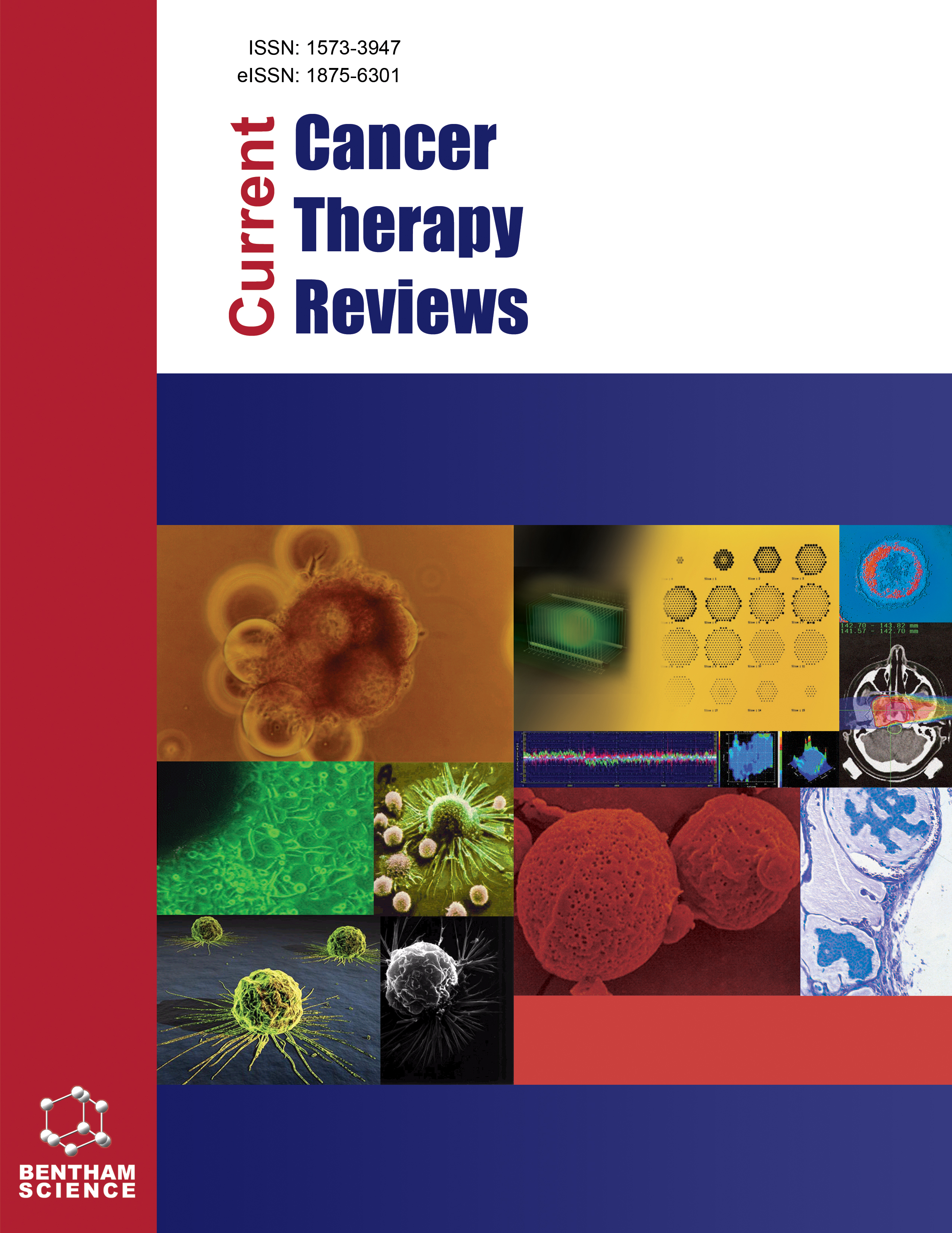- Home
- A-Z Publications
- Current Cancer Therapy Reviews
- Previous Issues
- Volume 15, Issue 2, 2019
Current Cancer Therapy Reviews - Volume 15, Issue 2, 2019
Volume 15, Issue 2, 2019
-
-
Systemic Therapies for Metastatic Testicular Germ Cell Tumors: Past, Present and Future
More LessAuthors: Sunil Parimi, Jennifer M. Rauw and Jenny J. KoTesticular germ cell tumors (TGCTs) are unique to that of most other solid tumors because they are highly curable in the metastatic setting. While the use of cisplatin-based chemotherapy continues to drive cure in this patient population, important improvements in the delivery of therapy, creation of risk-adjusted treatment paradigms, and salvage-therapy options have further enhanced survival as well. The future holds pr Read More
-
-
-
Implementing Cancer Exercise Rehabilitation: An Update on Recommendations for Clinical Practice
More LessAuthors: Kirsten Suderman, Carolyn McIntyre, Christopher Sellar and Margaret L. McNeelyA growing body of research evidence supports the benefit of exercise for cancer survivors both during and after cancer treatment. The purpose of this paper is to provide an update on our previously published review in 2006 on the state of the evidence supporting exercise for survivors of cancer as well as guidelines for integrating exercise programming in the cancer clinical setting. First, we provide a brief overview on the Read More
-
-
-
Beyond PD-1/PD-L1 Axis Blockade: New Combination Strategies in Metastatic Melanoma Treatment
More LessMetastatic melanoma treatment has dramatically changed in the last few years, having a breakthrough with the introduction of targeted agents and immunotherapy. PD-1/PD-L1 pathway is one of the physiologic mechanisms of peripheral immune tolerance, but it also represents a mechanism of tumor immune escape. PD-1/PD-L1 inhibitors represent new immune-checkpoint drugs currently used in metastatic mela Read More
-
-
-
A Review on Important Histone Acetyltransferase (HAT) Enzymes as Targets for Cancer Therapy
More LessAuthors: Mohammad Ghanbari, Reza Safaralizadeh and Kiyanoush MohammadiAt the present time, cancer is one of the most lethal diseases worldwide. There are various factors involved in the development of cancer, including genetic factors, lifestyle, nutrition, and so on. Recent studies have shown that epigenetic factors have a critical role in the initiation and development of tumors. The histone post-translational modifications (PTMs) such as acetylation, methylation, phosphorylation, and othe Read More
-
-
-
Statins: A Conceivable Remedial Role for the Regulation of Cancer Progression
More LessThe mevalonate pathway (also known as the cholesterol biosynthesis pathway) plays a crucial metabolic role in normal cell function as well as in the pathological environment. It leads to the synthesis of sterol and non-sterol isoprenoid biomolecules which subserve a variety of cellular functions. It is known to be deregulated in many disease processes. Statins and bisphosphonates are prominent inhibitors of the mevalo Read More
-
-
-
Possible Considerations for the Management of Turcot’s Syndrome?
More LessAuthors: Alexandrina Nikova, Dimitar Ganchev and Theodossios BirbilisBackground: Turcot’s syndrome (TS) is a rare disease with known incidence of about 1-2 cases per year. It is, however, linked to high mortality due to the brain cancer. And because of this, we propose recommendations, aimed at preventing the mortality of the patients and to minimize the risk of undiagnosed Turcot’s syndrome. Methods: The authors collected the worldwide published data on TS, from the year of its definition till Read More
-
-
-
Serotonin (5HTR2A and 5HTR3A) and GABA (GABAB) Receptor Genes Overexpression are Correlated with Non-small Cell Lung Cancer (NSCLC)
More LessAuthors: Seyed A. Razavi, Besharat Rahimi, Naghmeh Gholipour, Fatemeh Ahangari and Ghasem AhangariBackground: Lung cancer is one of the main causes of cancer mortality in both men and women. Up to 80% of lung cancers are Non-small-cell lung cancer (NSCLC). With regards to the role of serotonin, as an autocrine growth factor for small-cell lung cancer cells and gammaaminobutyric acid (GABA) and its receptors as a regulator in many types of cancers; the current study was conducted to investigate the expression of sero Read More
-
-
-
Chitosan Nanoparticles as a Carrier for Indigofera intricata Plant Extract: Preparation, Characterization and Anticancer Activity
More LessAuthors: Aliasgar Shahiwala, Naglaa G. Shehab, Maryam Khider and Rawoof KhanBackground: Cancer is one of the major causes of the death and affects people of all ages throughout the world. The drugs that are currently available to treat cancer have many side effects. Hence, there is considerable scientific interest in the continuing discovery of new anticancer agents from natural sources. The aim of this study was to prepare and characterize nanoparticles combining Indigofera intricata crude Read More
-
-
-
A Connecting Switch Among Aging, Diabetes and Tumor: Avenue Leading to Cancer Therapeutics
More LessIn recent, curiosity is at the forefront to understand the complexity of cancer driven by genetic, molecular and epigenetic programming due to life style, environmental pressure and metabolite adaptations. On the other hand, complex and heterogeneous nature of cancer is linked to the metabolic and molecular landscape of diabetic complications. This Letter to editor connects the dots and highlights the need to view can Read More
-
Volumes & issues
-
Volume 21 (2025)
-
Volume 20 (2024)
-
Volume 19 (2023)
-
Volume 18 (2022)
-
Volume 17 (2021)
-
Volume 16 (2020)
-
Volume 15 (2019)
-
Volume 14 (2018)
-
Volume 13 (2017)
-
Volume 12 (2016)
-
Volume 11 (2015)
-
Volume 10 (2014)
-
Volume 9 (2013)
-
Volume 8 (2012)
-
Volume 7 (2011)
-
Volume 6 (2010)
-
Volume 5 (2009)
-
Volume 4 (2008)
-
Volume 3 (2007)
-
Volume 2 (2006)
-
Volume 1 (2005)
Most Read This Month
Article
content/journals/cctr
Journal
10
5
false
en


